Many Questions Over Breakfast
with Etienne Delessert (Why Stop at Six?)
 March 10th, 2011 by jules
March 10th, 2011 by jules
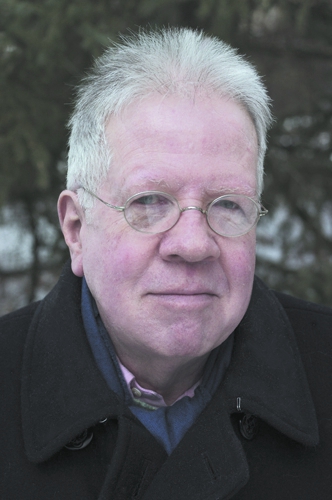 I’ve said somewhere before—perhaps it was here at 7-Imp, though my online stompin’ grounds run together sometimes, meaning it might have been that crazy, whacked out, hyper-hypo cyber-world called Facebook—that, if The Eric Carle Museum of Picture Book Art doesn’t put a halt to all their great exhibitions, I’m going to pack up my pillows and just move up there. It’d be that museum alone that would have me suffering the colder climes of the Northeast over the gentler winters of Tennessee. I’ll sweep their floors, hand out pamphlets, or stand out front with a sign board, dressed as a giant caterpillar. And I’ll even flip the board up into the air and catch it all cool, like sign board folks do. Just whatever the Museum would like. Because if you’re a giant picture book nerd, as I clearly am, it looks like it’s The Place To Be.
I’ve said somewhere before—perhaps it was here at 7-Imp, though my online stompin’ grounds run together sometimes, meaning it might have been that crazy, whacked out, hyper-hypo cyber-world called Facebook—that, if The Eric Carle Museum of Picture Book Art doesn’t put a halt to all their great exhibitions, I’m going to pack up my pillows and just move up there. It’d be that museum alone that would have me suffering the colder climes of the Northeast over the gentler winters of Tennessee. I’ll sweep their floors, hand out pamphlets, or stand out front with a sign board, dressed as a giant caterpillar. And I’ll even flip the board up into the air and catch it all cool, like sign board folks do. Just whatever the Museum would like. Because if you’re a giant picture book nerd, as I clearly am, it looks like it’s The Place To Be.
Case-in-point: One of their current exhibitions is of the work of Swiss-born artist Etienne Delessert. (Etienne currently makes his home in Connecticut.) Until June of this year in their East Gallery, one can take in a retrospective of his career as an illustrator in many settings, a career that has brought us, as the museum notes, more than eighty books collectively translated into fourteen languages. I’ve been trying this week, in thinking about this post, to pull up the words to adequately describe Delessert’s picture book art. Dream-like and surreal are what come to mind, yet those descriptors hardly seem adequate. In reviewing The Seven Dwarfs (2000), Publishers Weekly once described Delessert’s paintings as “{g}rotesque and delicate” with “{f}anciful, cinematic moments.” Hmmm…that’s getting closer. Bottom line, for me, is that there’s a mystery to his work that is often impenetrable, but this isn’t bad. It leaves me poring over his work, pondering, reflecting. Musing on.
Janine Despinette once referred to Delessert as an “inventor of universes.” Yes. That. It was in the museum’s Delessert exhibition catalog that I read that, which—I’m here to yawp—is fascinating reading for picture book aficionados. In “The World of Etienne Delessert,” included in the catalog, David Macaulay asks us to imagine a small New England town in which Etienne’s picture book protagonists meet at a diner to celebrate their creator:
Each of these characters was created to help tell a story to children. While the world they inhabit is not one of endless joy, smiles are never far away. It isn’t a world exclusively of imagination, although it stimulates curiosity and provides escape. It is a world occasionally touched by sadness and melancholy. Like his young audience, Delessert’s imagined world is always grounded in reality and perhaps this is its greatest and most important gift. The more fantastic the characters, the more realistically rendered are the backgrounds against which they frolic. Real trees. Real mountains. Real lakes. Where bright colors, warm light, and exuberant compositions create the most joyful of noises, there are also the colors of the earth—or no color at all, and shapes whose forms and motives remain unclear, and silence.
In the same catalog, Etienne ruminates on the notion of growing up, an essay whose title gets right to the point: “Why Grow Up?” “Good question—without a really good answer,” he begins, and then proceeds to address why he chose to write and illustrate for children in the first place. And what is the question that haunts him (as you can also see below)? “What is the mysterious power of a melody?…What is the equivalent in the fine arts?”
Did I mention that catalog is good reading? And, no, I don’t work for the museum. (Though, again, I think I could rock one of those caterpillar costumes…)
Etienne—sculptor, illustrator, animator, and painter, who creates art for both children and adults (“{h}is unflagging creative spirit has been engaged just as much in revealing the joy, absurdity, and cruelty of the real world to adults as well,” Macaulay wrote)—is here to discuss his early-career collaboration with Eugene Ionesco, how the children’s lit publishing landscapes differ between the U.S. and Europe, what it means to be an “outsider” artist, and much more. I’ve got the strong coffee brewing, and we’re ready to chat.
Two quick notes: Those interested in reading more about Delessert and his provocative thoughts on contemporary children’s book publishing can read this recent interview at the john seven collection. Also, seven heapin’ tons of thanks to Sandy Soderberg, Marketing Manager at the Eric Carle Museum, for her assistance with this interview, as well as illustrator Amy June Bates for helping me ponder just what to ask him.
And I thank Etienne for stopping by…
Jules: First off, what has it meant to you to have your work displayed at the Eric Carle Museum?
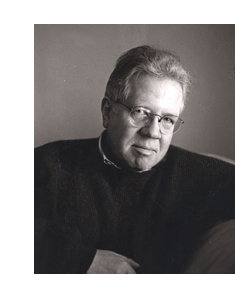 Etienne: I am very honored. Eric is an old friend, and the museum is beautiful. (It needs some banners outside, but the rooms are spacious and well-designed.) Eric has also been very generous in funding the construction of the building, and I hope that my work displayed there is a way to thank him for it.
Etienne: I am very honored. Eric is an old friend, and the museum is beautiful. (It needs some banners outside, but the rooms are spacious and well-designed.) Eric has also been very generous in funding the construction of the building, and I hope that my work displayed there is a way to thank him for it.
Jules: Are there specific experiences that formed the essential basis, the fundamental building blocks, of your artistic vision? Books, movies, artists, events, images, even dreams, etc.?
Etienne: If I were born in Paris, I would have been a filmmaker. There was no Swiss film industry at the time, and the “Nouvelle Vague”—Godard, Truffaut, Chabrol, etc.—directors looked like gods: they could write, shoot, work with actors. As a young man, I was intimidated by them. (How wrong I was probably!) So, I turned to picture books instead. I am, before all, a storyteller.
(Click to enlarge each)
I had very classical studies—Greek and Latin—so I was familiar with the mythology of these cultures.
I was also close to nature from birth. That’s the charm of Switzerland. And my mother had the wonderful skill to stage with me original plays. She would act some of the roles, then leave the room and let the 3-4 year old improvise, assuming all the characters. Great training.
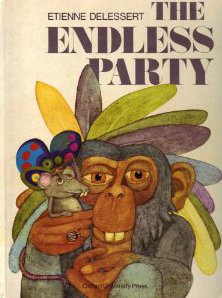 Growing up, I did not draw (I am an autodidact) before I was 23, but at 16, I discovered that I loved the concept of communicating ideas visually. With type, photos, or art. That’s why I became a graphic designer.
Growing up, I did not draw (I am an autodidact) before I was 23, but at 16, I discovered that I loved the concept of communicating ideas visually. With type, photos, or art. That’s why I became a graphic designer.
My literary heroes (still now!) were Kafka and the playwrights Beckett and Ionesco. They created their own world, and I have tried, very modestly, to follow their steps.
Bosch, Breughel, Klee, Steinberg had a real influence, way back.
In August, McSweeney’s McMullen will publish in the States the Stories 1, 2, 3, 4 that Ionesco wrote for me. I had illustrated the two first ones in 1968-1969, but the publisher Harlin Quist was a real crook, and Ionesco and I decided then to wait until we would be paid to work on the two other stories. It took forty years! Great and interesting challenge to go back, after such a long time and a life of experience, to the same characters. The original two books went everywhere in many co-editions and—with The Endless Party—were my first significant offerings.
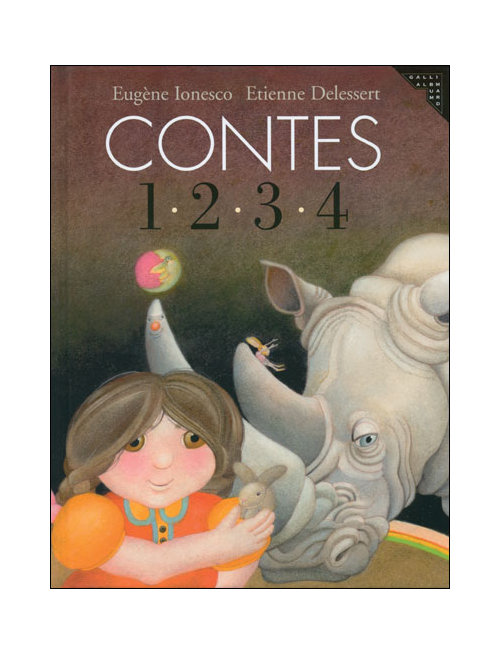
(Click to enlarge each)
(Click to enlarge)
Jules: What exactly is your process when you are illustrating a title? You can start wherever you’d like when answering: getting initial ideas, starting to illustrate, 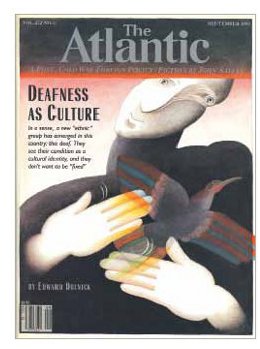 or even what it’s like under deadline, etc. Do you outline a great deal of the book before you illustrate or just let your muse lead you on and see where you end up?
or even what it’s like under deadline, etc. Do you outline a great deal of the book before you illustrate or just let your muse lead you on and see where you end up?
Etienne: I always write the text first. Words are so important — in a picture book or in a speech when you run for president. I am also trained to give a visual interpretation of a text by my editorial work for The New York Times, The Atlantic Monthly, or Le Monde in France.
I write in shorthand before going to the keyboard. I am already following the rhythm of the story, page after page, then I sketch the entire book on an 8½ x11″ piece of paper. Everything is there, down to the exact staging of the pictures. No dummy. Just one sheet of paper. I am just trying that way to keep the pleasure of doing the actual paintings.
(Click to enlarge)
I work each illustration on a tracing paper. That’s when the final drawing is completed; then I trace it on the paper, delimit the surfaces with a very fine crowquill pen with sepia ink before going to the watercolor, and finish with colored pencils.
There is absolutely no change in the concept of the book from the very first thumbnail sketches. It was all in my head. Colors and all.
(Click to enlarge)
In a complex way, most of my own books are autobiographical. Like Ashes, Ashes, about changing countries; A Long Long Song, what do we leave behind when it’s time to go?; or Humpty Dumpty. I was only interested in the wall he is falling from. In Alert!, I play with the post-9/11 idea that the “enemy” is more terrifying when you don’t know exactly who he is. In Big and Bad, I imply that the rules of war have recently changed; the little guys always finally win. So, ideas come from what I think about the world we live in: big, brutal Capital is governing, fear at every level, of losing jobs or identity, of cancer, also of not having real friends through social networks.
I am concerned. Children are also concerned. Their world is complex. They see and feel everything. They know about loneliness — or the desire to be left alone. They know about death — Grandma or the flattened squirrel on the road. They know about the joy of a fluttering smile.
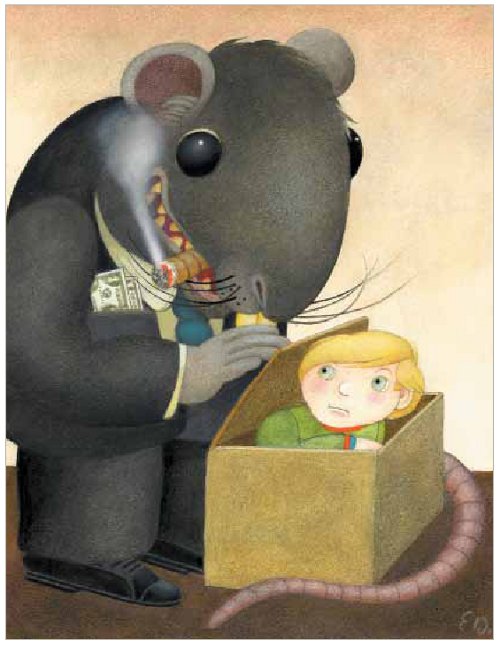
Kids want also to be entertained. They look at every detail again and again, a good reason to burn all those ultra-commercial, banal books produced by the publisher’s marketing department.
Any editor who says that he or she is free to choose his picture books, without getting first the approval of the marketing department, is a liar. That’s the state of affairs in this country. Once in a long while, there is a pearl in all those empty shells.
At least in France, there is some chaos and diversity, due to a number of independent, very small publishers that release 10 or 15 titles a year. They barely make it {and} pay nothing as advances, but there is a real energy. An energy that, in a few years, could give us masterpieces. (Well, I speak like Sendak!)
There is a real worry here in the States about losing our creative edge as a nation: It’s about time to give kids books that are subversive, so they can ask questions, and perhaps go on asking more questions when they grow up. A mass of questions will lead to some creative answers. And jobs. Simple!
(Click to enlarge)
Jules: Describe your studio or usual work space.
Etienne: We live in a big, old Victorian house. My wife Rita Marshall’s studio is across the alley. (She is a great book designer and {has been} a creative director for twenty years, who has shaped—with the owner Tom Peterson—The Creative Company in Mankato, Minnesota.) So, we communicate by interphone. I work in the attic, a large space with a serious mess all around. Very precise in my work. I like being, like Jean Piaget was saying, at the center of “a living disorder.”

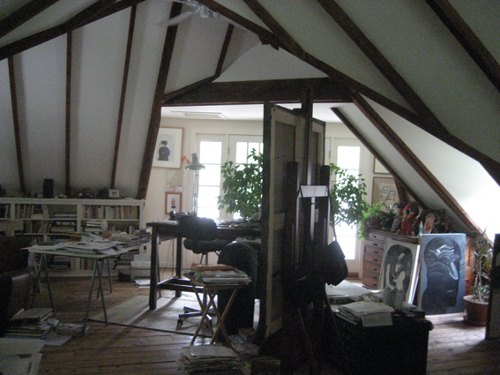
I always work on very different things at the same time: for instance, I start my days with skype and my keyboard to manage, pro bono, the French very independent Ricochet-Jeunes.org site, the biggest site devoted to children’s literature in Europe, with five million unique visitors yearly. I have been lately at the center of a battle to transfer the site in Switzerland, since the famed French system to finance culture with public money is completely broken. So, I have to deal these days with lawyers and judges and try to intimidate them with a huge very public media campaign. Fun, for a while…
The site was created fifteen years ago. I got involved to help friends three years ago and tried to introduce Ricochet—or an equivalent, since the structures are solid—in the States with the help of the Society of Illustrators in New York. It went nowhere. Yet.
Jules: I suspect authors and illustrators sometimes hate to be asked about “inspiration,” but can you tell me what typically inspires your story ideas. Hmmm….I guess that’s vague. Perhaps you could pick one title and address the question, if you’re so inclined. How about Moon Theater, as I find that to be such a beautiful, wondrous, mysterious tale.
Etienne: I’ll give you pictures…
(Click to enlarge each)
…but I prefer to speak about Spartacus the Spider, my latest.
It’s the story of a little spider whose parents have great expectations: they want him to be a killer! But he is a quite normal spider, does not know how to spin his threads, and flies laugh at him. Butterflies destroy the net.
He is quite desperate when a wandering mouse brings the news that, far away, scientists are busy duplicating spider threads to create extremely solid new cables.
Illustrations from Spartacus the Spider, 2010
(Click to enlarge each)
That gives strength and hope to our hero, and he adds lots of glue, changing the shape of his net. A huge butterfly gets caught. Instead of claiming victory, Spartacus is terrified: If the net is so strong, then birds, planes, planets, the Universe will be trapped in it. So, Spartacus decides to simply be a very normal, flawed, little spider again.
The idea of the book came when I was researching the biography of a far away Swiss cousin of mine, George de Mestral, who invented Velcro. (It could be my next book.) I learned about the involvement of scientists with spider webs. Another reason to draw Spartacus is that I hate spiders! (Have you ever looked a spider in the eye?)
That’s how a book is born.
(Click to enlarge second image)
Jules: What contemporary artists, if any, inspire you?
Etienne: There is good art everywhere, except in those snotty galleries. For me, the distinction between fine art and illustration is a joke: There are only good or bad pictures. Period. I have been lucky to have, over the years, six large retrospectives that presented my work to a large public.
Jules: What do you, as an artist, find most challenging and satisfying in the creative processes you employ?
Etienne: As I said, I am sort of an “outsider” artist: I have, still now, to solve all kind of problems, all the time, in every drawing. Keeps you fit, I guess.
But I love the very last moment, when the scans come back to me from the printer, ready to print, and I can alter and improve colors and minute details in Photoshop!
(Click to enlarge image)
Jules: You’re an artist, sculptor, animator, and illustrator. You’ve also said, “I’m always going back and forth from one style to another.” What style and/or medium do you find the most challenging in which to work? Is any one more rewarding, by chance, than the other in particular ways, too?
Etienne: Animation gives a great feeling of being the Creator: You draw a character, and you give life to him. It moves! But I have not been involved with animation for thirty years…
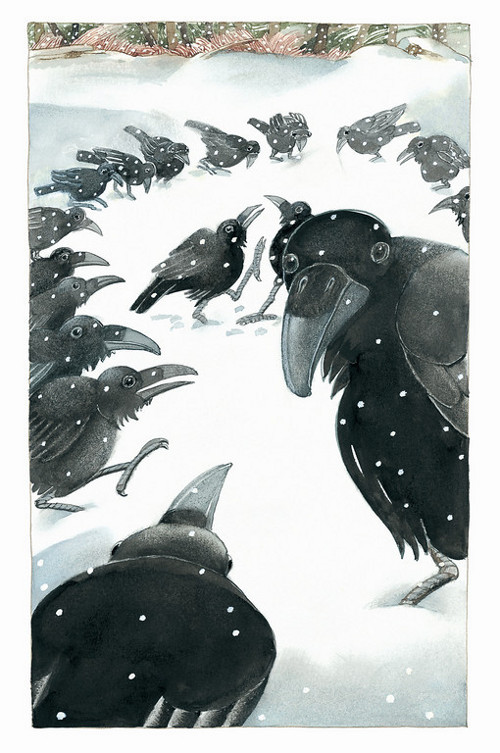
Jules: Do you create your books with a child audience in mind? In other words, some artists talk about how their audience is children, yet they consider them to be very much the same as adults. Your thoughts on that?
Etienne: Since I can do some violent political drawings, or dark odd paintings, I like to change my voice. I am still the same, but I try to be heard by children. I remember the wonderful experience I had working with Jean Piaget in 1970: There I learned to ask questions to children without influencing their answers.
I rarely go to schools — probably a mistake. That’s how you build sales! So, I have only a few reactions from children. But from China, Argentina, Europe, Israel, or Iran…
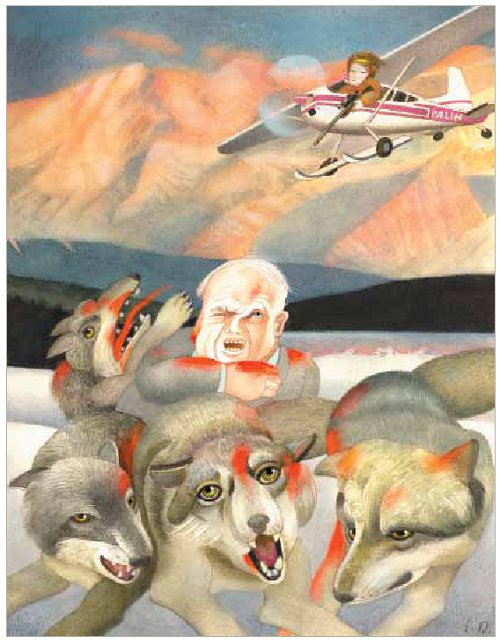
(Sarah Palin, candidate à la vice-présidence des Etats-Unis,
a encouragé vivement la chasse aux loups par avion),
political page for Siné Hebdo
Jules: As a book lover, it interests me: What books or authors and/or illustrators influenced you as an early reader?
Etienne: They were French-speaking authors and illustrators: Rojankowski, Hergé with Tintin for sure, Samivel, André François.
Jules: If you could have three (living) illustrators or author/illustrators—whom you have not yet met—over for coffee or a glass of rich, red wine, whom would you choose?
 Etienne: Wrong question. I have met the people I respect!
Etienne: Wrong question. I have met the people I respect!
Jules: Do you listen to music while you create books? (I know that may seem a bit off-the-point, but as a music-lover, I like to ask this of illustrators. Also, I love how you write about “the mysterious power of a melody” in your essay, “Why Grow Up?”)
Etienne: I am quickly bored by the actual work of painting. I am still an “idea-man,” so yes, I do listen to music, often quite loud. All kind of music, from rock to Stravinsky.
And I am fascinated by this question: Is there an equivalent to melody in visual arts?
Jules: Do you teach illustration? How does it inform your work, if at all?
Etienne: I do not teach, but I had many collaborators in my Carabosse animation studio. That was real teaching. And interaction.
Jules: What’s one thing that most people don’t know about you?
Etienne: That I have done so many drawings for magazines and newspapers. I have a retrospective about them next May in Switzerland {May 7 to October 30, 2011; see info on poster below}. And that I am so passionate about politics! That I growl like an angry bear. (We have one, once in while, coming for a nap in the park, thirty feet from my wife’s work table.)
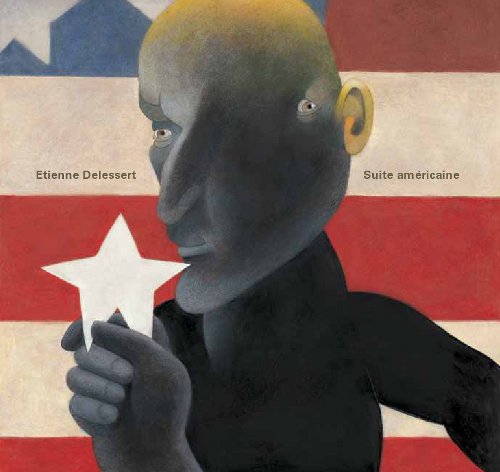
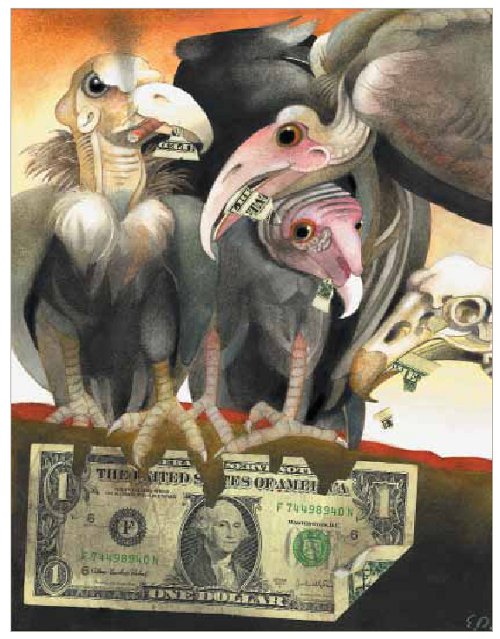
Jules: Any new titles/projects you might be working on now that you can tell us about?
Etienne: Yes, I am relaunching, thirty years later, a little character named Yok-Yok. In films and twelve books, he went around the world, and I felt guilty not to have given him then new friends and adventures. To keep a character alive, you have to feed the beast, especially these days. I had abandoned him, so he went to sleep in his nutshell.
Five completely new stories {will be} published in France by Gallimard-Giboulées — in two weeks. Let’s hope that Yok-Yok will come in America again! I am proud of the series. These books are aimed at very young readers — and their parents, who may remember Yok-Yok, with his big red hat, from thirty years ago. Yok-Yok is everywhere, in the house or the countryside. He explains some nonfiction facts with fantasy — and, I hope, with a magic and poetic touch.
A good sign: When I was working on these books, my wife told me she was happy to see me in such a good mood for six months!
Jules: Is there something you wish interviewers would ask you — but never do? Feel free to ask and respond here.
Etienne: Why am I a “good colorist”? Just by looking at the colors of nature. There is no ugly color. Take one and put it next to another, and it becomes beautiful. Just like people.
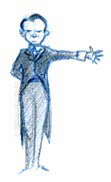
Jules: What is your favorite word?
Etienne: “Indigo.”
Jules: What is your least favorite word?
Etienne: “Cruelty.”
Jules: What turns you on creatively, spiritually or emotionally?
Etienne: The spiritual waves that link us with the dead, great people.
Jules: What turns you off?
Etienne: The inane attacks and debates of the actual Congress in Washington.
Jules: What is your favorite curse word? (optional)
Etienne: “Merde!” Not very original.
Jules: What sound or noise do you love?
Etienne: The song of a tiny bird.
Jules: What sound or noise do you hate?
Etienne: Police sirens.
Jules: What profession other than your own would you like to attempt?
Etienne: A bit late to change!
Jules: What profession would you not like to do?
Etienne: A Gaddafi foreign militia man these days in Libya.
Jules: If Heaven exists, what would you like to hear God say when you arrive at the Pearly Gates?
Etienne: First, I am not sure that Heaven exists. Or angels. If angels exist, then they should look like old, tired, very wise people, who know everything about love and sorrow. And do not look like the retouched, botoxed angels of the Renaissance.
God? He naps too often.
I’ll be there soon. I’ll let you know.
Opening photo used with permission of Etienne Delessert. Head shot of Etienne used courtesy of The Eric Carle Museum of Picture Book Art.
Illustrations from IONESCO CONTES 3 © 2009; from BIG AND BAD © 2008; from THE SEVEN DWARFS © 2000; from LUCAS © 2001; from FULL COLOR © 2001; from SPARTACUS THE SPIDER © 2010; from I HATE TO READ! © 1993; from I STILL HATE TO READ! © 2007. All by Etienne Delessert.
MOON THEATER. Copyright © 2009 by Etienne Delessert. Last spread reproduced by permission of the publisher, Creative Editions, Mankato, MN. All other illustrations from Mr. Delessert.
All other images are used with permission of Etienne Delessert.
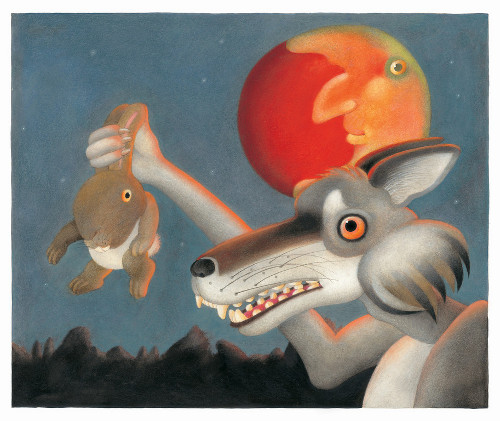
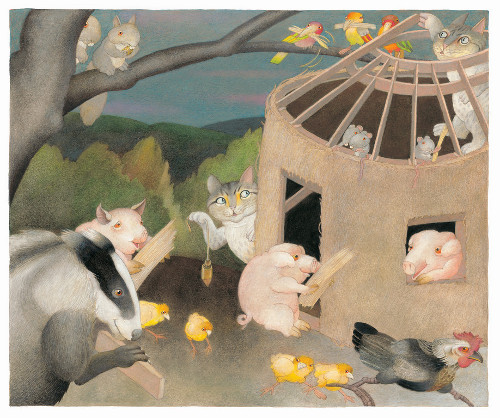
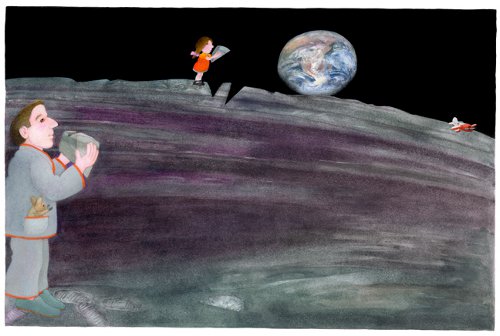
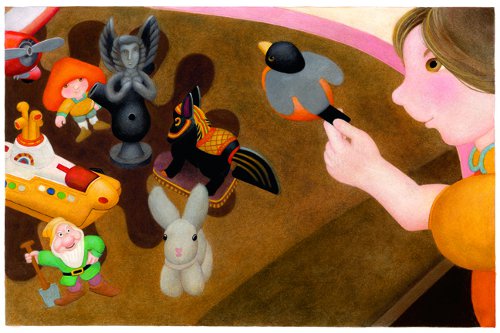
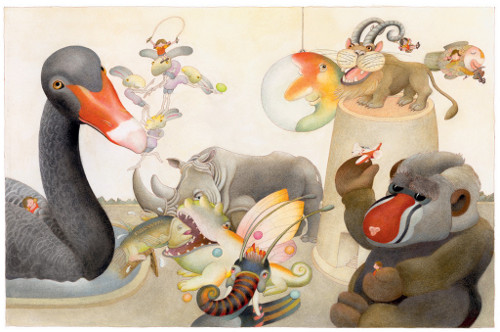
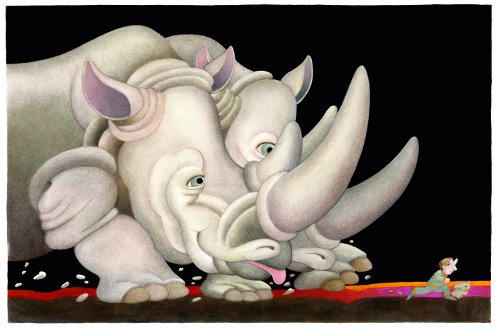
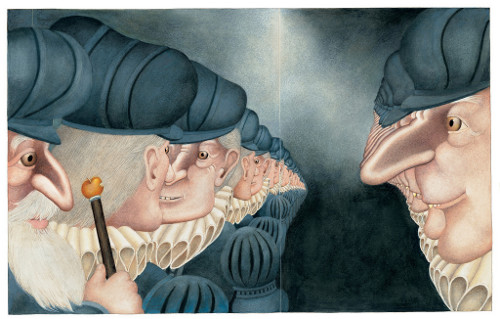
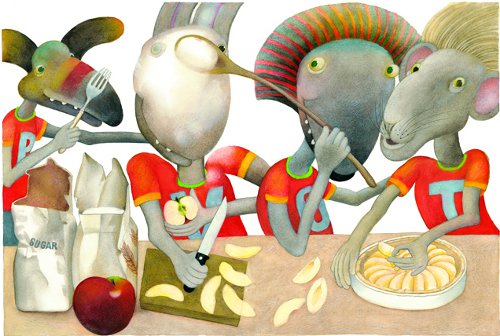
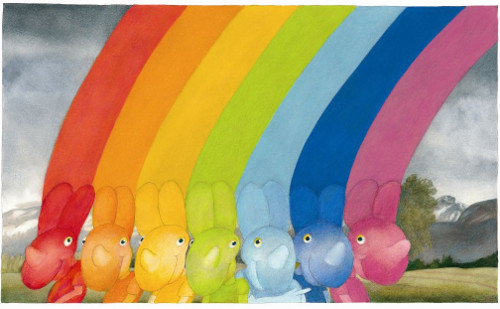

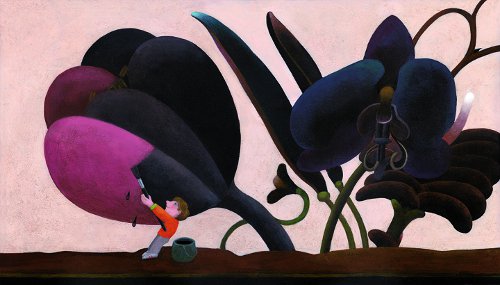
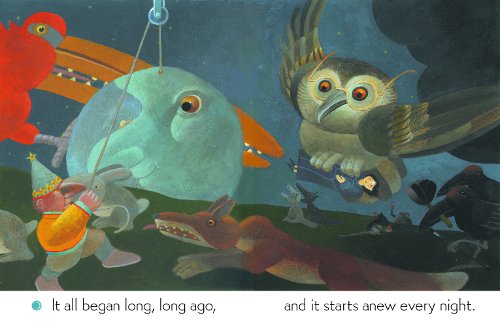
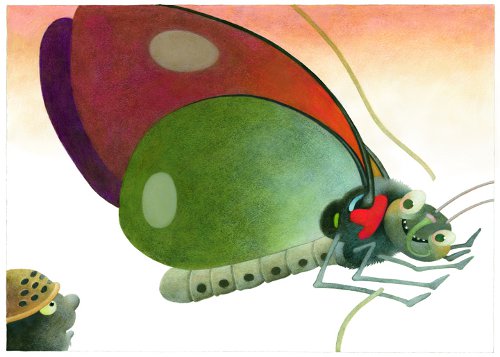
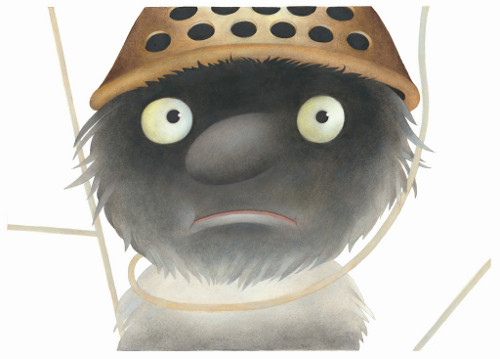
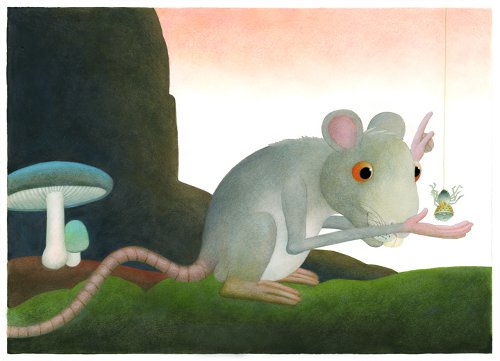
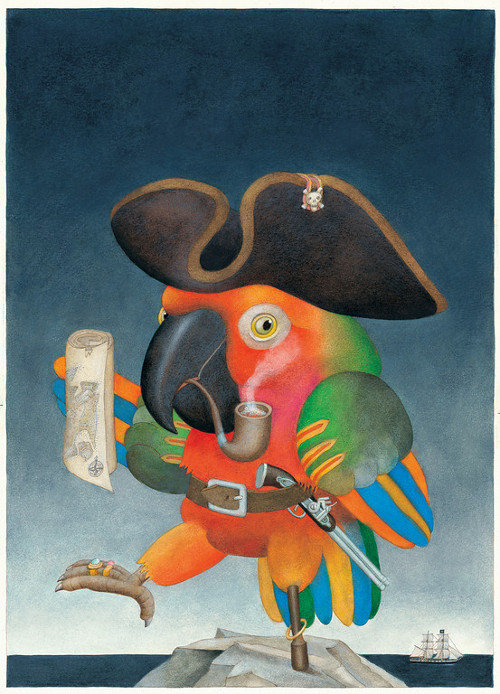
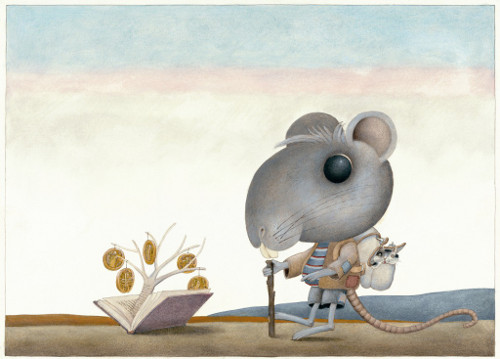

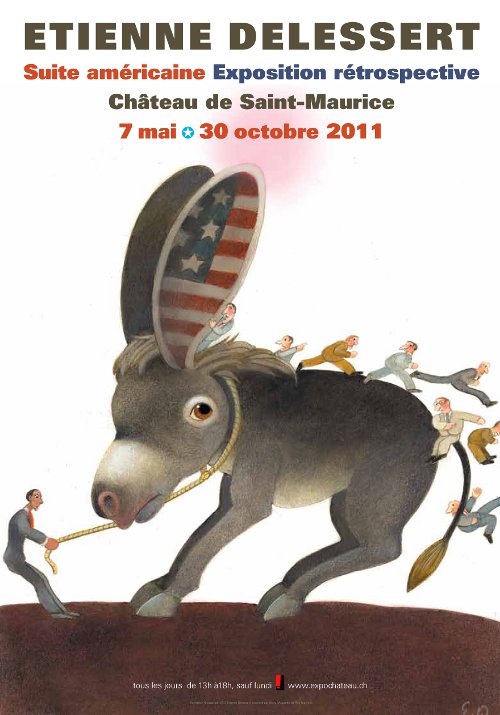
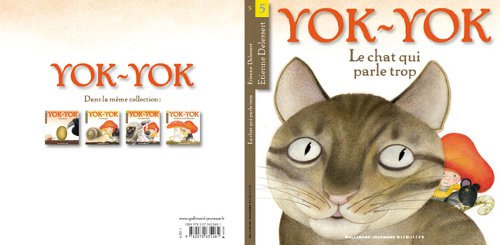
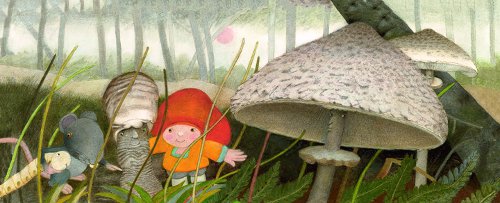
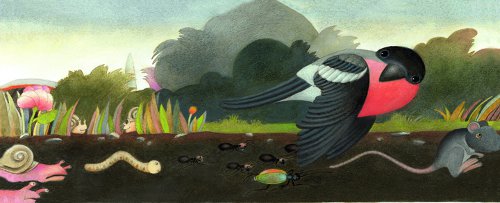
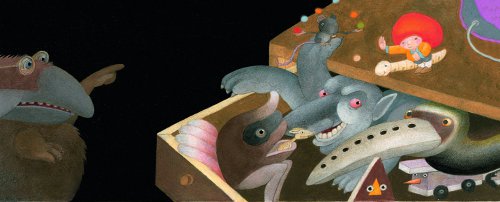
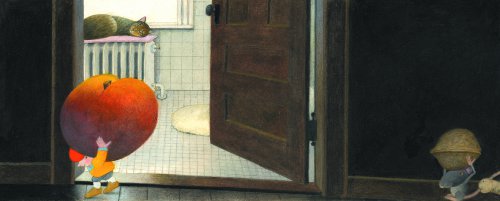

What a wonderful interview, lit up by passion and impatience. So interesting to glimpse some of the origins of these many wild worlds.
And Jules, you don’t have to dress up as a caterpillar or drive the caterpillar VW, but I hope you come visit the museum! Not only the art, but you’d be surrounded by some many kindred spirits,,, please? Before the girls grow up?
Such a wonderful interview, on so many levels… I love his artwork and his, uh, opinionation? is that a word? If it is, then he’s got it — and good for him!
(And I crave his house. Such a great studio!)
I am blown away by the dollar bill cover–that ought to be available as a poster everywhere, because people need a visual image of the banking corporations–and secondly, because I have a deaf character, those hands on the “deafness culture” cover. I had never heard of this artist before–thank you.
“Botoxed angels”!
Etienne Delessert’s drawings and paintings are a tour de force of psychological (mental and emotional ) resonance.
He can evoke our primordial fears and joys!
A perfect match for kids to make them wonder and marvel.
The ghost is always in the room, and he can remind us ~ in a very good way!
An important element of being fully alive….
On the top of it, he is also an excellent colorist!
During my most recent visit to the Carle Museum, I stayed with Mr. Delessert’s artwork for more than two hours. I went in prepared to be impressed and inspired, but it did much more for me.
As a poet, I’m sometimes hesitant to represent things the way I perceive them to be, or to speculate on how they might be, and I cling to notions of “consensus reality” that limit what I’m able to express.
Delessert moves outside the comfort zone of mimesis or flat representation so gracefully, into inner spaces with their own logic and conceptual appeal, without alienating the observer.
Thanks for this excellent interview!
The National Center for Children’s Illtrated Literature is extremely proud to call Etienne Delessert as one of our very own! The exhibit at the Carle, originated in Abilene, TX and Eric Carle Museum of Picture Book Art was the Perfect spot for its first stop. Etienne and his art will continue to WOW the audiences as it travels throughout the country! Thank you for a great Interview! Thank you Etienne!
What a wonderful energizing interview!
“There I learned to ask questions to children without influencing their answers.”
I think that quote tilted my universe just a little.
I think If there is parallel between melody and the visual arts, it might be something like a Picture book. Though perhaps one without words. Melody cannot be separated from time. It is an art that takes place through time. Picture books also are inseparable from the idea of time passing, although they can be dissected and looked at as individual images, it is like looking a one note or measure at a time rather than the entire melody.
Thanks Etienne! and Jules!
What a wonderful interview! And I’m so excited about the McSweeney’s release of the Delessert/Ionesco collaboration – I can’t wait! I was so excited to see this exhibition featured on one of my favorite blogs. Jules, you definitely have to come visit us at The Carle someday!
Everyone ahead of me has said it so beautifully…Jules, thank you for this amazing interview. It reminds me of why I wanted to be an illustrator/artist in the first place. Etienne Delessert is a master of color, mystery, and imagination. I see his work and I just melt .
He’s been one of my picture book heroes for a long time.
Thank you.
What a wonderful interview! Etienne Delessert will be giving a gallery tour and talk at The Carle on April 17 and he will be teaching a Master Art Class on May 20th. Visit carlemuseum.org for more information. Thanks!
Just wonderful. “Subversive”, just what I believe. He has truly been a spark in my career. Thank you.
thank you for this beautiful blog and introduction to an artist I never knew before! Plan to use the rainbow illustration in our newest blog and link back to you with credit to mr. delessert of course! Thanks again for this work!
[…] and cover from Eugène Ionesco’s Stories 1, 2, 3, 4,illustrated by Etienne Delessert (September […]
[…] Walker Danielson has an extensive post on and interview with Etienne Delessert, which I recommend to you for further […]
[…] à sa suite, comme une traînée d’étoiles, le blog « Seven impossible things to do before breakfast » et ses trouvailles. About these ads var wpcom_adclk_hovering = false; var wpcom_adclk_recorded = […]
My good friend , just now came across this interesting interview. YOU ARE THE GREATEST! Eric